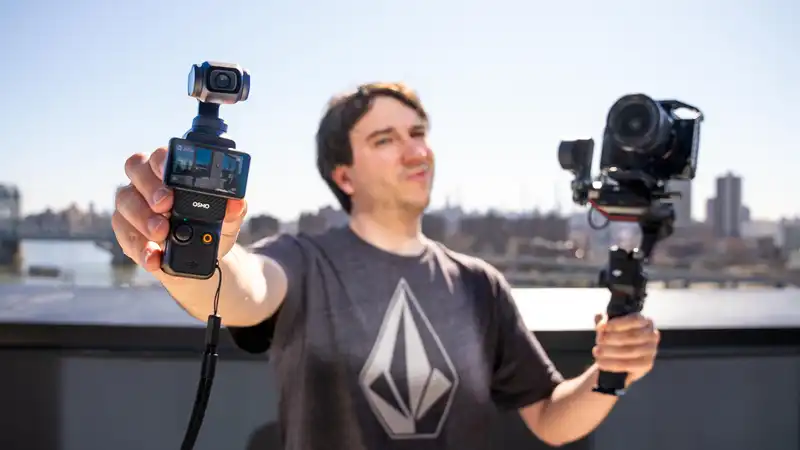Last week at SXSW, I used my DJI Osmo Pocket 3 as my only camera to capture festival highlights, explore Austin's hottest food spots, and film interviews and product demos. So, how well did the DJI Osmo Pocket 3 perform, and did we end up regretting leaving the Sony a7iii and the rest of our usual gear behind? Watch the full YouTube video to see the camera in action and its impressive results.
The DJI Osmo Pocket 3 is an all-in-one camera with a built-in gimbal that shoots super smooth video effortlessly. It received significant upgrades this year, including a larger 1-inch sensor that improves low-light image quality and depth of field, and a 2-inch flip-out screen that makes framing shots and changing settings a breeze.
For years I have used a full-size Sony a7siii, a DJI Ronin gimbal, and zoom lenses like the Sigma 24-70 as my main video kit. But honestly, after 8+ years in this business, my back is screaming. Just the thought of lugging it around during a few days of festivals was enough to make me break out in a sweat.
Not only does the Osmo Pocket 3 weigh less than my single lens, it is also much easier to pack: unlike my shooting kit, which tends to take up more than half of my PGYTech OneMo 2 camera bag (one of the best options for videographers), the Osmo Pocket 3 and all accessories fit neatly into one compartment. On this trip, it really helped to have less luggage.
The main reason I got the Osmo Pocket 3 is that I don't need a dedicated gimbal to capture smooth footage; even a compact gimbal like the DJI RS3 Pro is inconvenient to carry around and time consuming to set up; with the Pocket 3, an all-in-one camera much easier and faster, with equally smooth results.
This allowed me to focus on what was happening in the moment. There is no need to use both hands to move the camera, just point in the general direction of what you want to record. Just like a cell phone, the idea with the Osmo Pocket is that it is always in your pocket. As you have probably heard a thousand times, the best camera is the one you have with you. Whereas with my regular camera I sometimes questioned whether it was worth carrying around all day, the Pocket 3 is always with me, ready to capture whatever I find interesting. It has allowed me to capture moments that I would normally go out of my way to bring other equipment with me to capture.
If you want to up your audio game even more, the Osmo Pocket 3 allows you to easily pair up to two DJI Mic 2s via Bluetooth. Once paired with the Pocket, you can easily monitor and adjust both audio levels directly from the main screen.
I tried this setup in several interviews. Even without the optional lapel connected and relying on the microphone's internal audio, the sound quality proved to be top-notch. I also did not have to worry about disconnects or interference during the interview, as I could set it to automatically record 32-bit float audio internally as soon as I turned it on.
I am not a big fan of the pocket cover. They are meant to protect the gimbal and front screen, but they are not always quick to put on and usually do not even secure the camera so that it does not face outward. At the end of the trip, I found myself repeatedly discarding it for a speedier start/stop process, although I tried to treat the pocket delicately while it was in my pocket.
One of Osmo's tricks is the ability to quickly switch to "vertical" 3K recording. However, unlike the DJI Mini 3 and 4 Pro, which are comparable to drones, the lens itself does not physically rotate. In fact, it just digitally crops the sides to create a 9x16 video. This mode is useful because you can quickly make sure everything you need is in the center frame, but if you don't mind the extra steps in editing, shooting with a full sensor readout gives you the most flexibility later.
Coming from a more robust camera setup, I quickly noticed the lack of the ability to swap lenses or use the zoom lens to change perspectives; the wide field of view of the Osmo Pocket 3 was not enough to capture everything I saw on the Austin food tour and concert. It was great, but I struggled to record subjects up close or far away.
The Osmo 3, which is roughly equivalent to a full-frame 20mm f/5.4, has a more flattering depth of field than the iPhone 15 Pro's 24mm f/6.3 equivalent and punches above its class, especially in low light conditions. But as you can imagine, I missed the zoom range of the Sigma 24-70mm lens. The Pocket 3 has a 2x digital crop option, but it wasn't as convenient as my iPhone's 3-lens setup. As a result, I frequently preferred the iPhone, which allows me to quickly switch focal lengths.
After testing the Osmo Pocket 3 for a week straight, I found it to be an incredible travel camera. Capturing my experiences and being able to take it with me wherever I go, this camera met my needs, and you can see how I used this camera at SXSW in this YouTube video.
I plan to use the Osmo Pocket 3 as my main video camera on other trips, but I will probably still bring the a7siii and some sort of zoom lens for additional flexibility and range when needed. If DJI ever makes it possible to attach a zoom lens to this camera in the future, that would be a different story.
.









Comments